Oulu
| Oulu | |||
|---|---|---|---|
| — City — | |||
| Oulun kaupunki | |||
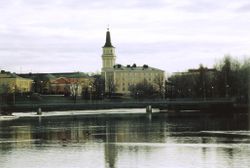 |
|||
|
|||
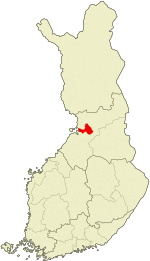 |
|||
| Coordinates: | |||
| Country | Finland | ||
| Region | Northern Ostrobothnia | ||
| Sub-region | Oulu sub-region | ||
| Charter | 1605-04-08 | ||
| Government | |||
| - City manager | Matti Pennanen | ||
| Area(2010-01-01)[1] | |||
| - Total | 1,513.42 km2 (584.3 sq mi) | ||
| - Land | 1,410.19 km2 (544.5 sq mi) | ||
| - Water | 103.23 km2 (39.9 sq mi) | ||
| Area rank | 67th largest in Finland | ||
| Population (2010-03-31)[2] | |||
| - Total | 139,579 | ||
| - Rank | 6th largest in Finland | ||
| - Density | 98.98/km2 (256.4/sq mi) | ||
| Population by native language[3] | |||
| - Finnish | 97.3% (official) | ||
| - Swedish | 0.2% | ||
| - Others | 2.4% | ||
| Population by age[4] | |||
| - 0 to 14 | 17% | ||
| - 15 to 64 | 70.5% | ||
| - 65 or older | 12.5% | ||
| Time zone | EET (UTC+2) | ||
| - Summer (DST) | EEST (UTC+3) | ||
| Municipal tax rate[5] | 19% | ||
| Website | www.ouka.fi | ||
Oulu (pronounced [ˈoulu] (![]() listen); Swedish: Uleåborg [ˈʉːleɔˌbɔrj], literally “Ule River Fort”) is a city and municipality of 139,579 inhabitants (31 March 2010)[2] in the region of Northern Ostrobothnia, in Finland. It is the most populous city in Northern Finland and the sixth most populous city in the country.
listen); Swedish: Uleåborg [ˈʉːleɔˌbɔrj], literally “Ule River Fort”) is a city and municipality of 139,579 inhabitants (31 March 2010)[2] in the region of Northern Ostrobothnia, in Finland. It is the most populous city in Northern Finland and the sixth most populous city in the country.
Contents |
History
Oulu was founded on April 8, 1605, by King Charles IX of Sweden opposite to the fort built on the island of Linnansaari. This took place after favourable peace settlements with the Russians, which removed the threat of attack via the main east-west waterway, the river Oulu. The surrounding areas were populated much earlier. Oulu is situated by the Gulf of Bothnia, at the mouth of river Oulujoki, which is an ancient trading site. One possible source for the name Oulu is a word in the Sami language meaning 'flood water', but there are other suggestions. Oulu was the capital of the Province of Oulu from 1776 to 2009.
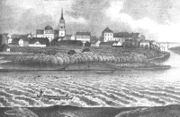
In 1822, a major fire destroyed much of the city. The architect Carl Ludvig Engel, chiefly known for the neoclassical (empire style) buildings around Helsinki Senate Square, was enlisted to provide the plan for the rebuilding of the city. With minor changes, this plan remains the basis for the layout of Oulu's town center. The Oulu Cathedral was built in 1832 to his designs, with the spire being finished in 1844.
From being a town known for wood tar and salmon in the past, Oulu has evolved into a major centre of competence in the field of high technology, particularly IT and wellness technology. Other prominent industries include wood refining as well as paper and steel industry. The University of Oulu is located six kilometres north of the city center. The Oulu Airport, located in neighbouring municipality of Oulunsalo, is the second busiest in Finland.
The municipality of Ylikiiminki was consolidated with the city of Oulu on January 1, 2009.
Name
There have been a number of suggestions for the origin of the name Oulu. One theory, and most probable, is that it would be a derivation of a Finno-Ugric word meaning "floodwater". This would be a loanword from the Saami language such as Southern Saami åulo, meaning "melted snow" or åulot meaning "thaw". It has also been speculated that the words väylä ("fairway, channel") and uoma ("river channel, bed") and their Northern Savo dialectic word uula is probably a loan from the Saami word oalli and is connected to the name Oulu. Another theory is that the Finnish word for flood, vuo, whose reconstructed form *uva has meant "river bed", is in the name's etymology.[6]
Geography
Climate
| Climate data for Oulu | |||||||||||||
|---|---|---|---|---|---|---|---|---|---|---|---|---|---|
| Month | Jan | Feb | Mar | Apr | May | Jun | Jul | Aug | Sep | Oct | Nov | Dec | Year |
| Source: Foreca | |||||||||||||
Culture
The best known cultural exports of the city of Oulu are Air Guitar World Championships, Mieskuoro Huutajat (also known as Screaming Men), and the now defunct metal band Sentenced.
There are many artists, writers and musicians resident in the city. A variety of concerts, both rock, classical music, and jazz, as well as other cultural events take place each year; for example, Oulu Music Video Festival – the host of the Air Guitar World Championships and Musixine Music Film Competition – in August, annual rock festival Qstock in July, the Oulu Music Festival in winter, the Oulunsalo Music Festival in summer, The Irish Festival of Oulu in October and the International Children's Film Festival in November. Kalmah is a melodic death metal-band from Oulu,Finland that formed in 1998.
Notable people from Oulu
- Leevi Madetoja composer
- Three former Presidents of the country, Kaarlo Juho Ståhlberg, Kyösti Kallio and Martti Ahtisaari
- Black metal band, Impaled Nazarene.
Sights

- Tietomaa, a science center with over 150 exhibits
- Ainola Park, formerly a university botanical garden before the university was moved to Linnanmaa
- The Rapids Center, the area in the estuary of the Oulu river consisting of small islands connected with bridges, fountains in the middle of the river, and including a housing area of building blocks planned by Alvar Aalto
- Rotuaari pedestrian street
- The Market Square with the City Library, the City Theatre and old salt and tar storehouses
- Mannerheim Park
- The Oulu Cathedral
- Hupisaaret, a large park area located in the estuary of the Oulu river
- The F. M. Franzen memorial
- The Northern Ostrobothnia museum
- The Pateniemi Sawmill Museum
- The Vehicle Museum
- The University of Oulu Botanical Garden (situated in Linnanmaa)
- The Oulu Art Museum
- The Arctic Gallery
- Technopolis, the technology village
- Turkansaari (website) (historical outdoor museum)
Other points of interest
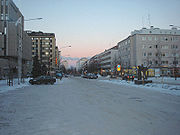
- Oulu Music Video Festival
- Air Guitar World Championships
- Qstock Rock Festival (website)
- Jalometalli Metal Music Festival
- Jalometalli Winterfest
- Madetoja Hall, housing the Oulu Music Centre (website) the residence of the Oulu Symphony Orchestra
- Oulu Hall (a large indoor sports facility consisting of a low dome, which looks somewhat like a landed flying saucer)
- Terwa Marathon & Run event in late May (since 1989)
- The Terva-skiing event in early March (since 1889)
- The Winter Swimming World Championship
Education
The University of Oulu and Oulu University of Applied Sciences (formerly Oulu Polytechnic) are located in Oulu.
Oulu is home to the most northerly architecture school in the world. The school is best known for its strong regionalistic ideas for developing architecture. This movement is named "the Oulu school" ("Oulun koulu") of architecture.
Transportation
Oulu is served by Oulu Airport, the second biggest airport in Finland by passenger volume. Oulu Airport is located in the neighbouring county of Oulunsalo, 15 kilometres (9 mi) from the city centre.
Port of Oulu is one of the busiest harbours within the Bothnian Bay. Port of Oulu includes four separate harbour areas: Vihreäsaari oil and bulk docks, Nuottasaari docks, Oritkari docks and the Toppila docks.
The shortest travel time from Oulu Railway Station to Helsinki Central Railway Station is 5 h 44 mins, operated by VR. Other destinations include, for instance, Kolari, Rovaniemi, Seinäjoki and Tampere.
The most important road in Oulu is highway 4 (E8/E75) that runs from Helsinki to Utsjoki via Lahti, Jyväskylä, Oulu, Kemi and Rovaniemi. Other highways running to and from Oulu are highway 20 to Kuusamo and highway 22 to Kajaani.[7]
Employment
As of December 31, 2005, the active working population was employed as follows:[8]
| Industries | Working population |
|---|---|
| Services | 36,616 |
| Industry | 11,439 |
| Commerce | 9,394 |
| Construction | 4,659 |
| Transport | 4,469 |
| Farming and forestry | 471 |
| Unknown | 1,200 |
| Total | 68,248 |
In 2008, the most important employers were:[8]
| Employer | No. of employees |
|---|---|
| City of Oulu | 9,760 |
| Northern Ostrobothnia Hospital District | 5,546 |
| Nokia Group | 4,700 |
| University of Oulu | 3,050 |
| The Oulu Region Joint Authority for Education | 1,651 |
| Stora Enso Group | 1,155 |
| Kesko Group | 1,054 |
| Itella Corporation | 920 |
| Cooperative Arina Group (S Group) | 830 |
| Deaconesses' Institution | 694 |
Sports
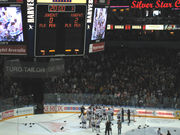
The Oulu ice hockey team Kärpät have won the Finnish Elite League (SM-Liiga) Championship title five times (1981, 2004, 2005, 2007, and 2008). They have also been the runner-up in the European Champions Cup twice, in 2005 and 2006.
Oulu has 2 teams in the highest bandy division. Oulun Luistinseura, OLS, has become Finnish champions 14 times, and Oulun Palloseura, OPS, 7 times. In 2001 the city was the main venue for the Bandy World Championships.
Terwa Marathon & Run is an annual event run in late May (since 1989)
International relations
Twin towns — Sister cities
Friendship cities
See also
- Toppila Power Station
References
- ↑ "Area by municipality as of 1 January 2010" (in Finnish and Swedish) (PDF). Land Survey of Finland. http://www.maanmittauslaitos.fi/sites/default/files/pinta_alat_kunnittain_01012010.pdf. Retrieved 23 November 2010.
- ↑ 2.0 2.1 "Population by municipality as of 31 March 2010" (in Finnish and Swedish). Population Information System. Population Register Center of Finland. http://www.vrk.fi/vrk/files.nsf/files/ACFC13B2F489698CC22577030039BD73/$file/20100331.htm. Retrieved 13 April 2010.
- ↑ "Population according to language and the number of foreigners and land area km2 by area as of 31 December 2008". Statistics Finland's PX-Web databases. Statistics Finland. http://pxweb2.stat.fi/Dialog/varval.asp?ma=060_vaerak_tau_107_fi&ti=V%E4est%F6+kielen+mukaan+sek%E4+ulkomaan+kansalaisten+m%E4%E4r%E4+ja+maa%2Dpinta%2Dala+alueittain++1980+%2D+2008&path=../Database/StatFin/vrm/vaerak/&lang=3&multilang=fi. Retrieved 29 March 2009.
- ↑ "Population according to age and gender by area as of 31 December 2008". Statistics Finland's PX-Web databases. Statistics Finland. http://pxweb2.stat.fi/Dialog/varval.asp?ma=050_vaerak_tau_104_fi&ti=V%E4est%F6+i%E4n+%281%2Dv%2E%29+ja+sukupuolen+mukaan+alueittain+1980+%2D+2008&path=../Database/StatFin/vrm/vaerak/&lang=3&multilang=fi. Retrieved 28 April 2009.
- ↑ "List of municipal and parish tax rates in 2010". Tax Administration of Finland. 24 November 2009. http://www.vero.fi/download.asp?id=5853;25512. Retrieved 13 January 2010.
- ↑ http://scripta.kotus.fi/www/verkkojulkaisut/julk125/oulunsalo/oulun_etymologia.shtml
- ↑ AffectoGenimap Finland Oy (2006). Autoilijan Tiekartta 2007 – Road map [map], 1:800,000. ISBN 978-951-593-047-7.
- ↑ 8.0 8.1 "Business and industry". Information about Oulu. Oulu: City of Oulu. 2008-09-15. http://www.ouka.fi/city/english/elinkeinot.asp. Retrieved 5 January 2009.
- ↑ 9.0 9.1 9.2 9.3 9.4 9.5 9.6 9.7 9.8 "Twin towns". www.ouka.fi. http://www.ouka.fi/kansainvalisyys/english/ystavyyskaupungit.html. Retrieved 2009-11-07.
- ↑ "Информация о городах-побратимах" (in (Russian)). www.arhcity.ru. 2007-10-26. http://www.arhcity.ru/?page=232/0. Retrieved 2009-09-17.
- ↑ Bursa Metropolitan Municipality Web Site; Sister Cities.
External links
- City of Oulu – Official website
- Oulu travel guide from Wikitravel
- 65 Degrees North: Oulu's English Language Newspaper
- Oulu This Week event calendar
|
||||||||||||||
|
|||||||||||||||||||||||||||||||||||||||||||||||||||||||||||||||||||||||||||||||||||||||||||||||||||||||

